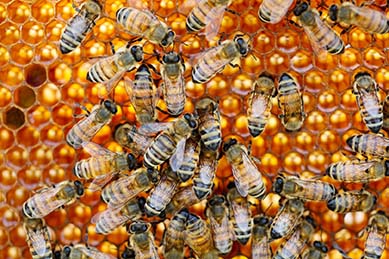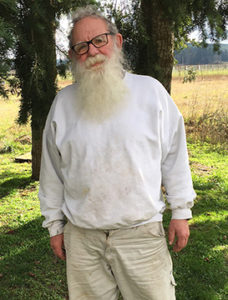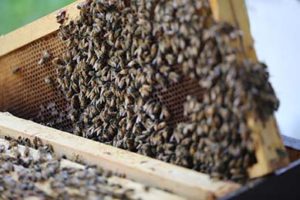Jefferson County Master Gardeners who attended the February 9 lecture and meeting in Chimacum got a crash course in honey bee biology from Harold Prather, treasurer of the East Jefferson County Beekeeper’s Association, http://ejbees.org/
This is the slow season for beekeepers like Prather, when cold temperatures keep their colonies tucked in their hives, clustered together as they vibrate their wing muscles for warmth. That is, until they need to poop. Bees, as it turns out, are housebroken, according to Prather, and when temperatures reach about 50 degrees F., they evacuate the hive whenever the urge to defecate strikes.
Flight Risk
These cold weather flights aren’t without risk. If a bee stuffed with honey, its source of carbohydrate nutrition, leaves the warmth of the sun and flies into the shade of a tree where the temperature has fallen below 45 degrees, it may simply fall out of the sky, Prather says; not the outcome a beekeeper hopes for.
Prather maintains 10 hives, more than most of his 40-odd counterparts in the association who have three or four. For an operation his size, Prather must register his colonies and pay a $25 fee to the Washington Department of Agriculture. What! you exclaim; you have to pay the government to manage a bee hive? It’s not so bad, he explains. A small keeper with one to five hives pays $5 annually, while Prather pays the higher figure. The money goes to Washington State University’s queen bee rearing program. And, a registered bee keeper can send his dead bees to the agriculture department for a determination of the number and type of mites that no doubt caused the demise. The sad plight of feral honey bee colonies has been much publicized in recent years. The chief culprit, according to Prather, is the Varroa destructor, a parasite that represents the largest single contributor to the modern day decline of wild honeybees. Today, Prather says, if we’re going to have bees, we have to have beekeepers who treat their colonies for parasites.
Cheaper than Golf
And what prompted the white-maned Prather to become a beekeeper? They’re fascinating creatures, he says. I like them. And, I like honey. Beekeeping isn’t a money maker but it’s cheaper than golf.
Come April, or perhaps even earlier as Olympic Peninsula temperatures rise, honeybees get busy harvesting maple pollen, for protein, and nectar, for carbohydrates as soon as the trees begin to flower. Things settle down again after that, until blackberries begin to blossom, when off go the worker bees in search of more protein and nectar, and the cycle continues throughout the summer months. The female worker bees comprise up to 95 percent of each colony, according to Prather, and they run the show more or less as a democracy, if you can have a democracy in which the other members of the colony, the drones (males) and the queen, are not invited to vote.
Queen Bee or Sex Slave?
Think you’d like to be a queen? Perhaps not a queen bee, whose role is pretty much that of a sex slave, in Prather’s words. When the workers determine that overcrowding in the hive or a shortage of food mean it’s time for the colony to split in two, they designate 7 to 10 cells within the beehive as queen cells, whose occupants, otherwise ordinary worker bees, are stuffed with royal jelly, which Prather describes as a mixture of pollen, nectar and an enzyme gathered from the heads of other workers. Not only is the diet of the queens-to-be richer than the bee bread (a mixture of pollen and nectar) fed to other denizens of the hive, they are fed much more frequently than their worker and drone counterparts. What happens when you eat copious amounts of rich food? You get big, really big, and size is all that distinguishes the queen from her sisters.
Flying Shape
As the new queens fatten, pheromones urge about half of the colony to get ready for travel. They reduce the food supply offered to the old queen and get her in flying shape, and on a signal only a worker bee understands, the travelers and their queen swarm out of the hive looking for a new home. Meanwhile, the first of the new queens emerges from her cell and promptly kills the other candidates for royalty, thereby ensuring her own supremacy. After a week to 10 days, our new queen has her time in the sun as she takes flight in search of drones–and sex–mating as many as 15 or 20 times, Prather estimates. For the drones, these mating flights are a fleeting pleasure. Once they’ve performed their evolutionary duties and inseminated the queen, they die. Bachelor drones that never mate don’t fare much better. The workers kick them out of the hive in the fall rather than labor all winter to feed them.
Our queen, on the other hand, stores the male issue in her spermatheca, a small, round organ in her abdomen, where she accumulates a lifetime supply of sperm during the early mating flights. Like the hapless drones, once a queen runs out of sperm and no longer serves a purpose within the hive, the workers kill her. With her mating flights under her belt, the young queen return to the hive and goes to work, laying fertilized eggs that become workers and unfertilized eggs that become drones. As Prather explains honey bee genealogy, a drone has a grandfather, e.g., the male chromosomes he receives from the queen whose egg was fertilized, but no father in that his own egg was not.
Organic Honey?
Workers divide and conquer, some managing the food stores within the hive and others ranging up to three miles away in search of pollen and nectar. Prather snickers at the notion of organic honey: You have no idea where they go. Who knows if somebody has sprayed the side of the road? Plant nectar goes into a roaming bee’s honey stomach, where an enzyme breaks down sugars. When the bee returns to the hive, it regurgitates the contents of its stomach as other bees place it in individual, hexagonal cells within the hive, where temperatures average about 95 degrees. It takes 17 to 19% moisture to convert the material to create honey, Prather says, and workers fan the cells with their wings to create evaporation. When moisture levels reach the proper percentage, they cap the honey cells, and its good forever, Prather says. As proof, he argues that honey was found in 5,000-year-old tombs in Egypt’s Valley of the Kings and remained perfectly edible. Honey is a natural antibiotic, he says, and the ancient Egyptians used it in their medicines. If you’ve got a wound that’s not healing, he says, rub some honey on it.
Waggle Dance
And what of our swarm that evacuated the hive? Perhaps you’ve seen a swarm of honey bees clinging to a tree branch as they search for a new home, like a hole in the trunk of a tree or the eaves of your house. The quivering mass can include thousands, or even tens of thousands of bees, as scouts search the neighborhood for new digs. When a scout discovers what it regards as a suitable nest site, it returns to the colony and performs its waggle dance, a figure eight maneuver that alerts other bees to the direction and distance of the discovery. Now, more scouts fly off like real estate agents to evaluate the prospective nest, and when they have a quorum, the colony takes flight. If you see a swarm, says Prather, call your local beekeeper or the fire department before it takes up residence in your eaves. He and his colleagues are happy to bring a swarm trap to the scene, gather the bees and find them a more suitable home. And that, he says, beats the $150 it costs to buy a colony.





